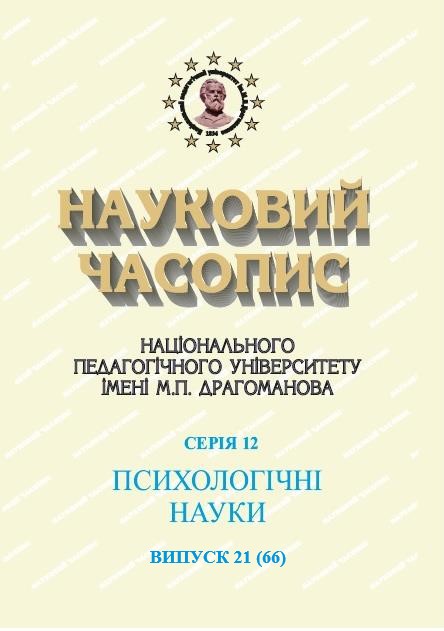THEORETICAL ANALYSIS OF INFLUENCE OF LIFE CIRCUMSTANCES ON MANIFESTATIONS OF AGGRESSIVE BEHAVIOR
DOI:
https://doi.org/10.31392/NPU-nc.series12.2023.21(66).06Keywords:
aggression, aggressiveness, aggressive behavior, forms of aggressive behavior, components of aggressive behavior and factors of aggressive behavior.Abstract
The article highlights the results of a theoretical review of research of the interrelationships and influence of different life circumstances on the manifestation of a human aggressive behavior. Many Ukrainian and foreign specialists from various fields of knowledge, such as psychologists, sociologists, and psychiatrists have been analyzing the phenomenon of aggression. Currently, there are many studies on aggressive behavior of people of different ages and genders. The factors that contribute to the emergence of aggressive behavior, such as stress, negative environmental influences, failures and disappointments, inadequate communication, environmental influences, and mental illnesses, have been studied. The relevance of the problem of aggression in the world today is determined, and the danger that can follow aggressive behavior is explained. It is noted that the consequences of aggression can be an increasing level of violence and crime, which will have a negative impact on the whole society. The factors that contribute to human’s aggressive reactions in various life situations have been identified. The importance to form internal and external factors to overcome aggression, that is, a variety of life circumstances that can encourage a person to manifest aggressive behavior in various forms and at different ages, is explained. In particular, there are a variety of works dedicated to the research of various events that provoke the emergence of aggression, such as the influence of traumatic events, unfavorable family relationships, etc. Different forms of aggression have been described and differences in tendencies towards different forms of aggression of girls and boys are explained. It is noted that boys are more prone to physical aggression, while girls are more inclined to verbal and indirect aggression. It is emphasized that the emergence of aggressive behavior is based on various factors, both internal and external. It is noted that there is a model of aggression that defines its components such as the characteristics of the environment, characteristics of the external environment, motivational-target component, cognitive, emotional and volitional components, etc. Attention is focused on the reasons that lead to the emergence of aggression at different ages. At the same time, the importance and necessity to prevent and correct aggression is justified.
References
- Baranovska, M.V., & Hurina, Z.V. (2021). Psykholohichni chynnyky vplyvu ahresii u pidlitkiv [Psychological factors influencing aggression in teenagers]. Perspektyvy rozvytku suchasnoi psykholohii: zbirnyk naukovykh prats – Prospects for the development of modern psychology: a collection of scientific papers, 9, 13–18 [in Ukrainian].
- Bretsko, I.I., Burtyn, M.I., & Buchmei, I.I. (2022). Vplyv stosunkiv u simi na ahresyvnist u ditei. [The influence of family relationships on aggressiveness in children]. Zbirnyk tez dopovidei za materialamy Mizhnarodnoi naukovo-praktychnoi konferentsii. Stanovlennia osobystosti profesionala u postkovidnomu prostori – A collection of theses of reports based on the materials of the International Scientific and Practical Conference. The formation of the personality of a professional in the post-Covid space (May 12-13, 2022, Mukachevo). (26-28). Mukachevo: Publishing House of MSU [in Ukrainian].
- Volodarska, N.D., & Kohut, O.O. (2017). Proiavy ahresii yak psykholohichnyi zakhyst osobystosti v kryzovykh sytuatsiiakh [Displays of aggression as psychological protection of the individual in crisis situations]. Fundamental and applied researches in practice of leading scientific schools, 1(19). 9–20 [in Ukrainian].
- Hrabovska, S., & Yesyp, M. (2010). Problema kopinhu v suchasnykh psykholohichnykh doslidzhenniakh [Copings’ problem in present psychological studies]. Sotsiohumanitarni problemy liudyny – Socio-humanitarian problems of man, 4, 188–199 [in Ukrainian].
- Zhurat, Yu.V. (2020). Osoblyvosti dytiacho-batkivskykh vzaiemyn, shcho vplyvaiut na formuvannia ahresyvnoi povedinky u doshkilnomu vitsi [Peculiarities of child-parent relationships that affect the formation of aggressive behavior in preschool age]. Naukovo-praktychna konferentsiia “Osobystist u prostori problem KhKhI stolittia” – Scientific and practical conference “Personality in the space of problems of the 21st century” (February 5, 2020, Kyiv). (p. 46-48) Kyiv : Natsionalnyi universytet “Kyievo-Mohylianska akademiia” [in Ukrainian].
- Kazannikova, O.V. (2020). Spetsyfika ahresyvnoi povedinky ditei doshkilnoho viku [The specifics of aggressive behavior of children of preschool age]. Zbirnyk tez dopovidei uchasnykiv X mizhnarodnoi naukovo-praktychnoi internet-konferentsii: Suchasnyi rukh nauky – Modern movement of science: theses add. X International Scientific and Practical Internet Conference (April 2-3, 2020, Dnipro). (Vol.1, p. 494-498). Retrieved from: https://dspace.pdau.edu.ua/server/api/core/bitstreams/802cfd50-cd2c-4b8b-bb76-51b0f7582d67/content [in Ukrainian].
- Kachanova, Yu.V. (2010). Ahresyvnist ta ahresiia yak sotsiolohichni katehorii [Aggressiveness and aggression as sociological categories]. Naukovi pratsi. Sotsiolohiia – Scientific Sociology, 133(146), 50–54 [in Ukrainian].
- Oros, O.B. (2018). Ahresyvna ta nasylnytska povedinka sered ditei pidlitkovoho viku [Aggressive and violent behavior among adolescent children]. Zbirnyk naukovykh prats. Visnyk NTUU “KPI”. Politolohiia. Sotsiolohiia – Bulletin of NTUU “KPI”. Politology. Sociology. Law: a collection of scientific works, 2(38), 90–96 [in Ukrainian].
- Rudenko, L.M. (2012). Protsesualni kharakterystyky ahresyvnoi povedinky [Procedural characteristics of aggressive behavior]. Naukovyi chasopys Natsionalnoho pedahohichnoho universytetu imeni M. P. Drahomanova. Seriia: Korektsiina pedahohika ta spetsialna psykholohiia – Scientific journal of the National Pedagogical University named after
P. Drahomanov. Series 19: Correctional pedagogy and special psychology: coll. of science works, 21, 418–424. [in Ukrainian]. - Stepaniuk, O. (2020). Metodychnyi posibnyk dlia fakhivtsiv, yaki vprovadzhuiut typovu prohramu dlia kryvdnykiv [Methodical guide for specialists implementing a typical program for offenders]. Kyiv : Organization for Security and Co-operation in Europe [in Ukrainian].
- Shcherban, T.D. (2022). Ahresiia yak psykholohichnyi fenomen u suchasnomu studentskomu seredovyshchi [Aggression as a psychological phenomenon in the modern student environment]. Mizhnarodnyi naukovyi zhurnal “Osvita i nauka” – International scientific journal «Education and Science», 1(32), 113–119 [in Ukrainian].
- Auslander, W., Sterzing, P., Threlfall, J., Gerke, D., & Edmond, T. (2016). Childhood Abuse and Aggression in Adolescent Girls Involved in Child Welfare: The Role of Depression and Posttraumatic Stress. J Child Adolesc Trauma, 9,1–10. doi: 10.1007/s40653-016-0090-3
- Warburton, W., & Anderson, C. (2015). Aggression, Social Psychology. International Encyclopedia of the Social & Behavioral Sciences (2nd edition), 1, 373–380. http://dx.doi.org/10.1016/B978-0-08-097086-8.24002-6

